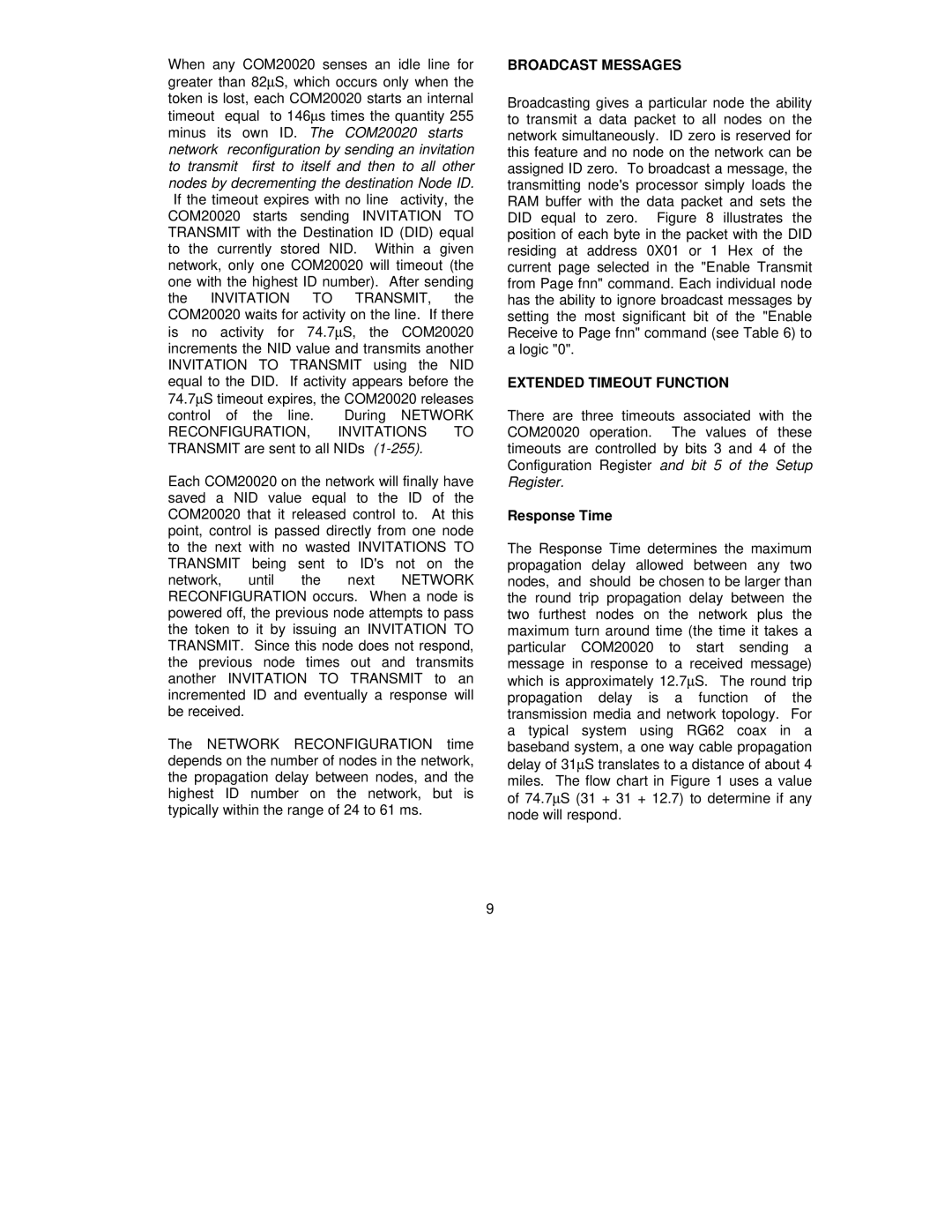When any COM20020 senses an idle line for greater than 82μS, which occurs only when the token is lost, each COM20020 starts an internal timeout equal to 146μs times the quantity 255 minus its own ID. The COM20020 starts network reconfiguration by sending an invitation to transmit first to itself and then to all other nodes by decrementing the destination Node ID. If the timeout expires with no line activity, the COM20020 starts sending INVITATION TO TRANSMIT with the Destination ID (DID) equal to the currently stored NID. Within a given network, only one COM20020 will timeout (the one with the highest ID number). After sending the INVITATION TO TRANSMIT, the COM20020 waits for activity on the line. If there is no activity for 74.7μS, the COM20020 increments the NID value and transmits another INVITATION TO TRANSMIT using the NID equal to the DID. If activity appears before the 74.7μS timeout expires, the COM20020 releases
control of the line. During NETWORK
RECONFIGURATION, INVITATIONS TO TRANSMIT are sent to all NIDs
Each COM20020 on the network will finally have saved a NID value equal to the ID of the COM20020 that it released control to. At this point, control is passed directly from one node to the next with no wasted INVITATIONS TO TRANSMIT being sent to ID's not on the
network, until the next NETWORK RECONFIGURATION occurs. When a node is powered off, the previous node attempts to pass the token to it by issuing an INVITATION TO TRANSMIT. Since this node does not respond, the previous node times out and transmits another INVITATION TO TRANSMIT to an incremented ID and eventually a response will be received.
The NETWORK RECONFIGURATION time depends on the number of nodes in the network, the propagation delay between nodes, and the highest ID number on the network, but is typically within the range of 24 to 61 ms.
9
BROADCAST MESSAGES
Broadcasting gives a particular node the ability to transmit a data packet to all nodes on the network simultaneously. ID zero is reserved for this feature and no node on the network can be assigned ID zero. To broadcast a message, the transmitting node's processor simply loads the RAM buffer with the data packet and sets the DID equal to zero. Figure 8 illustrates the position of each byte in the packet with the DID residing at address 0X01 or 1 Hex of the current page selected in the "Enable Transmit from Page fnn" command. Each individual node has the ability to ignore broadcast messages by setting the most significant bit of the "Enable Receive to Page fnn" command (see Table 6) to a logic "0".
EXTENDED TIMEOUT FUNCTION
There are three timeouts associated with the COM20020 operation. The values of these timeouts are controlled by bits 3 and 4 of the Configuration Register and bit 5 of the Setup Register.
Response Time
The Response Time determines the maximum propagation delay allowed between any two nodes, and should be chosen to be larger than the round trip propagation delay between the two furthest nodes on the network plus the maximum turn around time (the time it takes a particular COM20020 to start sending a message in response to a received message) which is approximately 12.7μS. The round trip propagation delay is a function of the transmission media and network topology. For a typical system using RG62 coax in a baseband system, a one way cable propagation delay of 31μS translates to a distance of about 4 miles. The flow chart in Figure 1 uses a value of 74.7μS (31 + 31 + 12.7) to determine if any node will respond.
